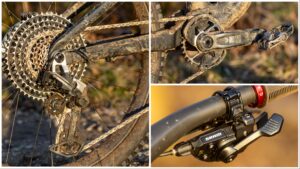With a couple of simple changes to the specification is could be a total trail blazer
Merida One-Twenty 400 review
By using wheelsize specific frames for the size S and M bikes, Merida gives riders the option of 27.5in or 29in wheels on the two smallest sizes.
>>> The best cheap mountain bikes in 2019

Merida One-Twenty 400 review
Launched earlier this season, the new Merida One-Twenty has been repositioned as a short-travel trail bike, and less of an XC/ Marathon endurance machine. And this is reflected in the geometry, its 66.4 degree head angle slacker that a lot of longer travel bikes. It’s also the only bike in this test to come with the wider 148mm Boost rear end, which makes it much easier to upgrade or replace the wheels.
For a new platform however, the frame still feels a tad short and tall, where the elevated top tube reduces standover clearance on the size L. This overall sensation of being slightly perched on the bike, rather than being sat in it, is compounded by the lack of saddle height adjustment. Limited by a kinked seat tube design, and the location of the rocker link pivot, if ever there was a bike that needed a dropper post… it’s this one. And given that the Merida is one of the more expensive bikes in this category, it really should come fitted with one as standard.

Merida linkage sandwiches the shock at both ends
Suspension
Given its model name, you’d assume the One-Twenty has 120mm of travel, but when we measured the vertical wheel travel, Merida’s floating shock linkage actually delivers 129mm. Not that we’re complaining, because plenty of bikes don’t deliver the full quota of claimed travel, let alone 9mm more than claimed.
That extra travel out back also means that frame travel matches suspension fork travel to within 1mm, where Merida has opted for the beefier Suntour XCR 34, which is exactly what you need on a 29er. That’s because the bigger wheel has more leverage on the fork, so it’s critical that the proportions of the fork are scaled up to match the wheelsize. On the trail the extra steering precision of the XCR 34 is appreciable, and it really gives you the confidence to charge hard. Unfortunately, it’s not the most sensitive fork here and it has an annoying rattle that’s present on every single bump.

Burly Suntour XCR 34 tracks true but doesn’t flinch on small hits
Components
Sporting a wide-range 11-46t cassette combined with a 32t chain ring, you’d be forgiven for thinking that the Merida could keep up with the Calibre Bossnut on the climbs. Factor in the increased gearing effect of the bigger 29in wheels however, and long steep climbs on the Merida will have your legs screaming for a 30t chain ring up front.
With the 1x Shimano SLX kit shifting is flawless, the clutch style Shadow Plus rear derailleur and ample frame protection on both the chain and seat stays offering a silent ride. Which is probably why we noticed the fork rattle so much. It also allowed us to focus on the profile of the handlebar, which has too much back sweep and is a touch too narrow.

11-46t cassette and 32t chainring offers a wide gear range
Performance
From the get go the Merida One-Twenty felt solid and direct. You can tuck in behind the burly XCR 34 fork, release your grip on the Shimano brakes and really let the big 29in wheel steamroll over everything. It pedals with ruthless efficiency too, so it accelerates easily even with the additional weight of the bigger 29in wheels. So in every respect, the Merida is a fast bike.
The Maxxis Forekaster tyres don’t do Merida any favours though, as you can hear the side knobs pinging of roots and rocks even when conditions are bone dry.
So the Merida could be even faster with better tyres but the congested suspension is also holding it back. Granted, it’s nothing like as bunged up as the Jamis, but both ends of the Merida lack the pitter-patter response found on the Giant and Calibre.

















